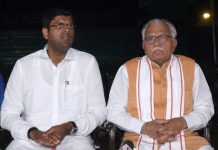 ENGLAND, JUNE 2013. Playing with a team that was similar to the current World Cup squad, Mahendra Singh Dhoni led India to a fascinating win in the Champions Trophy. He became the only captain to have won all the short-format International Cricket Council (ICC) tournaments — World T20 championship during his debut as a skipper, the 2011 World Cup and now the Champions Trophy. He was on top of the cricketing world. MSD was on an LSD-like high.
ENGLAND, JUNE 2013. Playing with a team that was similar to the current World Cup squad, Mahendra Singh Dhoni led India to a fascinating win in the Champions Trophy. He became the only captain to have won all the short-format International Cricket Council (ICC) tournaments — World T20 championship during his debut as a skipper, the 2011 World Cup and now the Champions Trophy. He was on top of the cricketing world. MSD was on an LSD-like high.
In 2013, MSD didn’t complain about the bowlers’ immaturity. He never cribbed that he couldn’t select three pacers and two spinners in his final XI. He played with Ishant Sharma, Bhuvneshwar Kumar, Umesh Yadav, Ravichandran Ashwin and Ravindra Jadeja. He wasn’t worried about the fragility of the middle-order batting, or the ability of the top order, which comprised Shikhar Dhawan, Virat Kohli, Dinesh Karthik, Rohit Sharma, Suresh Raina and himself.
MSD has a similar team in 2015 — the same batsmen and bowlers. But his team seems to be in tatters. During the recent tri-nation series (India-England-Australia) in Australia, India lost three out of the four games; the remaining one was washed out. The captain seems to have lost the plot; he looks un-cool and is prone to emotional outbursts, both on and off the field. Many observers feel it will either be tough or impossible for India to defend the World Cup.
Today, MSD is upset with his bowlers, middle-order batsmen, team selection; in fact, with almost everything. He expressed these sentiments during the tri-nation series. For example, he said that given the chinks in the middle-order, he couldn’t play with five bowlers (three seamers and two spinners), as it exposed the batting if the team lost a couple of quick wickets. If he played with four bowlers, the opposition capitalised on it. The problem: lack of performing all-rounder(s).
These concerns should have loomed larger in 2013, when several batsmen and bowlers were inexperienced. If MSD talks about these issues 20 months later, and weeks before the World Cup, it implies two things. First is that a few players are out of form and injured, which is somewhat true of the current team. Second is that there is a problem with the team’s captain and his attitude. Several cricketing brains feel that the issue with India is Dhoni himself.
During the tri-nation series, Sunil Gavaskar, who captained India to glory in the 1985 mini World Cup on Australian soil, said that the Indian skipper looked “short of ideas” while leading the side. The former Indian opener was angered by the players’ attitude — “most of the Indian batsmen looked like they just wanted to give up” — but his comment reflected on the captaincy, too. It is the skipper’s job to inculcate the right mindset.
“Dhoni is not a thinker; he is instinctive. The latter strategy doesn’t always work,” says Harish Thawani, founder-chairman, Nimbus Communications, which has won several cricket telecast rights.
So what’s really wrong with MSD? Why is he unable to deliver these days?
~Also Read~
[egpost postid=”231250″ byline=”false”]
STUMPED BY STATISTICS
India’s win-loss record in ODIs overseas is dismal. This is especially true when it plays in Australia, New Zealand, England and South Africa, where the pitches have life, bounce and pace. In the past decade, of the 54 ODI matches played in these countries, India won 16 and lost 30, an average win ratio of 30 percent. If one looks at the statistics in the past five years, the win ratio dropped to 22 percent, or seven wins in 32 games. Obviously, India does well in the subcontinent.
Since the World Cup is held in Australia and New Zealand, one cannot expect MSD to do miracles, and win seven or eight of the nine matches — six league games and three knockouts, including quarters, semis and final — to win the tournament. Given the draw — two groups of seven teams each — India may need to win eight games, rather than six or seven. Pool B has India, South Africa, Pakistan and the West Indies. Although it is an easier group — Pool A has Australia, Sri Lanka, England, New Zealand and Bangladesh — India have to win five of the six matches to qualify as No. 1 or 2 in the group.
In that case, going by current form, it may play Sri Lanka, England or Bangladesh in the quarterfinals. If India win only three or four games, and are No. 3 or 4 in Pool B, they may have to face Australia or New Zealand, who are playing excellent cricket and have the home advantage, in the knockout stage. Winning against either of these teams, both of which will play on home pitches, will be tough.

BOWLED BY BAD LUCK
Since May 2013, MSD was embroiled in several controversies. His name cropped up in the match-fixing and betting scandals. Although he denied it vehemently, the media mentioned it regularly. Last month, he told reporters: “I know one thing, irrespective of what is there, when it comes to Indian cricket, my name keeps popping up (in the IPL scandal). Now that this (Justice Mudgal report and the Supreme Court order) has been settled, something new will pop up… If there is nothing, some speculative story comes up, big or small. I have to keep dealing with all these things.”
MSD’s godfather and Board of Control for Cricket in India (BCCI) president N Srinivasan, who treats him as his son, faced ethical and legal flak from the courts and critics. The apex court ordered Srinivasan to sell Chennai Super Kings (CSK), an IPL franchise, to be re-elected as BCCI head. Both of them faced allegations of “conflict of interest” because they seemed to combine cricketing and commercial interests. Dhoni’s wife Sakshi has also been photographed laughing and talking to a bookie.
Worse, it was rumoured that Dhoni had ego clashes with some of his teammates and team director Ravi Shastri and was, in fact, urged to quit as Test captain after the Australia series, but announce it whenever he wished to, even after the World Cup. To get back at those who made this suggestion, he abruptly and shockingly announced it after the fourth Test, with one Test left. Over time, these developments affected the skipper’s on-field actions and decisions.
RUN-OUT BY EMOTIONS
Captain Cool is no longer ice-cold on and off the field. He shows regular glimpses of anger, frustration, even desperation. In the must-win match against England in the tri-series, MSD shouldered-arm a throw from Mohammad Shami, a fast bowler, and “berated” him for not being in a finer fine-leg position to stop Jos Butler’s paddle-sweep. Butler’s knock helped England win. In the same match, Dhoni was seen several times with hands on his hips — signs of frustration — as England fought back from 67 for five to chase 201.
“Even earlier, Dhoni had emotions, but he could keep them under control as he had a mature team, with senior players who knew what they had to do,” says former Indian off-spinner Aashish Kapoor. “Now, he feels desperate with the recent performances with the final exams (World Cup) a few weeks ahead. Hence, the display of emotions.”
For example, a player in the 2011 World Cup team, which won the cup, wouldn’t have to be told where to field, like Shami had to be.
What gets MSD’s goat is that the current squad is not a rookie one. It may be full of younger players, but they have been around for a while. Even the so-called inexperienced bowling attack comprises Ishant, who played his first ODI in 2007, and has almost 80 of them under his belt, and Yadav, Shami and Kumar, each of whom has played more than 40 ODIs.
~Also Read~
[egpost postid=”231280″ byline=”false”]
HIT-WICKET BY TEAM SELECTION
In the 2013 Champions Trophy, MSD could play with five bowlers, as the all-rounder(s), especially Jadeja, performed admirably with the bat and ball. With Dhawan, Rohit and Dhoni in form and Kohli not to be taken lightly, the top- and middle-order clicked perfectly. As Tom Moody, former Australian all-rounder, then said: “This new-look Indian ODI team (after the stalwarts from the 2011 World Cup team, like Sachin Tendulkar, Gautam Gambhir, Virender Sehwag, and Yuvraj Singh) is better in the field, (running) between the wickets, fearless with the bat and carry no baggage.”
Twenty months later, an almost similar team has become MSD’s headache. The major reason is the manner in which the captain has handled these players. Kohli’s spot was shuffled between No. 3 and 4, despite the fact that he loves to bat at No. 3. Dhoni’s excuse was to give flexibility to the batting line-up; if a wicket fell early, he wanted to protect Kohli, the star batsman, and send him at No. 3 only when the openers gave a flying start. But the move has affected Kohli’s batting in the recent past.
The skipper has asked off-spinner Ashwin to bowl an unusual line — around and outside the leg stump with a packed leg-side field. The same is the case with left-arm bowler, Jadeja, who was asked to bowl a line where the ball came in rather than spin away, to cramp the batsmen. In both cases, the bowlers lost their initial sting and edge, which was evident in 2013.
The point is that in 2011, Dhoni had a team that was full of excellent players. Within two years, he managed one that was largely of his own choice. The new players were hungrier; they were willing to lay their lives for the captain. But since MSD is not a thinking cricketer, and more impulsive, his tactics caused more harm. The teammates had no idea about what they were supposed to do because the skipper would change his tune every now and then.
But India and 1.3 billion countrymen will still pin their hopes on MSD. He has won the country so many trophies in the past; he can do it again. He is Mahendra Midas, who can transform an ordinary team into world-beaters. He has the batsmen, who can chase 350 or 400 runs without panic. He has bowlers, such as Ishant, who can run through the opposition on his day. He has all-rounder(s), such as Ashwin and Jadeja, who can energise any team.
As Kapoor says, if someone can win the trophy again for India, it is Dhoni. “MSD has the knack and luck to win big tournaments with not-so-good or average teams. He did it in the Champions Trophy. He did it with CSK in many IPL seasons; there was one season when CSKhad to win all its seven games on the trot, and it did,” he explains. But for this to happen in the World Cup, Dhoni will have to be good behind the stumps, and better in front of them.
letters@tehelka.com










